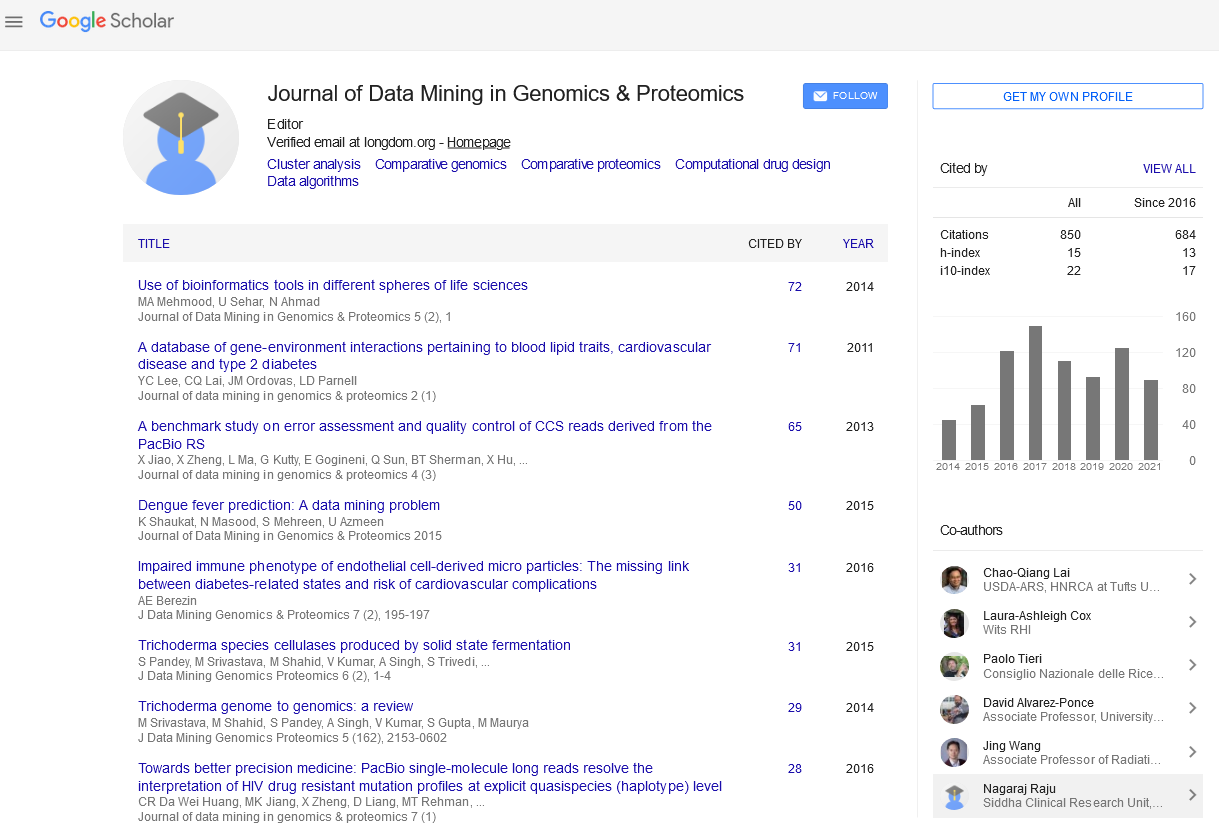PMC/PubMed Indexed Articles
Indexed In
- Academic Journals Database
- Open J Gate
- Genamics JournalSeek
- JournalTOCs
- ResearchBible
- Ulrich's Periodicals Directory
- Electronic Journals Library
- RefSeek
- Hamdard University
- EBSCO A-Z
- OCLC- WorldCat
- Scholarsteer
- SWB online catalog
- Virtual Library of Biology (vifabio)
- Publons
- MIAR
- Geneva Foundation for Medical Education and Research
- Euro Pub
- Google Scholar
Useful Links
Share This Page
Journal Flyer

Open Access Journals
- Agri and Aquaculture
- Biochemistry
- Bioinformatics & Systems Biology
- Business & Management
- Chemistry
- Clinical Sciences
- Engineering
- Food & Nutrition
- General Science
- Genetics & Molecular Biology
- Immunology & Microbiology
- Medical Sciences
- Neuroscience & Psychology
- Nursing & Health Care
- Pharmaceutical Sciences
Wnt5a/beta-catenin signaling pathway as a new molecular target for developing therapeutic strategies for keloid
2nd International Conference on Big Data Analysis and Data Mining
November 30-December 01, 2015 San Antonio, USA
M. Ghazizadeh, S. Igota, S. Egawa and M. Tosa
Nippon Medical School, Japan
Posters-Accepted Abstracts: J Data Mining Genomics Proteomics
Abstract:
Wingless type (Wnt) signaling pathway has been implicated in the pathogenesis of keloid. Wnt functions through two main pathways of canonical or beta-catenin- dependent and non-canonical or beta-catenin-independent signaling. Previously we reported that Wnt5a/beta-catenin signaling pathway may play a critical role in keloid pathogenesis. In this study, we further evaluated this role through functional analysis. Primary fibroblast cultures and tissue samples from keloid (KF) and normal appearing dermis (NF) were used. Induction of NF and KF with recombinant Wnt5a peptide resulted in an increase in protein levels of total beta-catenin and phosphorylated beta-catenin at Ser33/37/Thr41 but no significant change in phosphorylated betacatenin at Ser45/Thr41 positions. In addition, the expression of total GSK3-beta protein was not affected but its phosphorylated/ inactivated form was increased in NF and KF. Inhibition of Wnt5a by specific anti-Wnt5a antibody reversed these effects. Ca2+/ calmodulin dependent protein kinase (CaMKII) is a main downstream target in the non-canonical Wnt signaling pathway and promotes beta-catenin degradation. Inhibition of the CaMKII by its specific inhibitor tatCN21 peptide showed a decrease in total beta-catenin and phosphorylated beta-catenin at Ser45/Thr41 and no change in GSK3-beta level. Taken together, these findings confirm that the canonical Wnt/beta-catenin pathway triggered by Wnt5a is involved in keloid pathogenesis thus provides a new molecular target for developing therapeutic strategies.
Biography :
M. Ghazizadeh has completed his M.D. in 1975 and residency in urologic surgery in 1980. In 1984, he has received his Doctor of Medical Sciences from the University of Tokushima School of Medicine, Japan. He is an Associate Professor and Chief of the Department of Molecular Pathology, Institute of Gerontology at Nippon Medical School, Japan. He has served as the Director of the Central Institute for Electron Microscopy Research at Nippon Medical School, Tokyo, Japan. He has received several grants-in-aid from the Ministry of Education, Culture, Science, Sport and Technology of Japan and has published more than 100 papers in reputed scientific journals. He is on the editorial board of the Journal of Nippon Medical School, The Open Dermatology Journal, World Journal of Dermatology, and Journal of Submicroscopic Cytology and Cytopathology.


